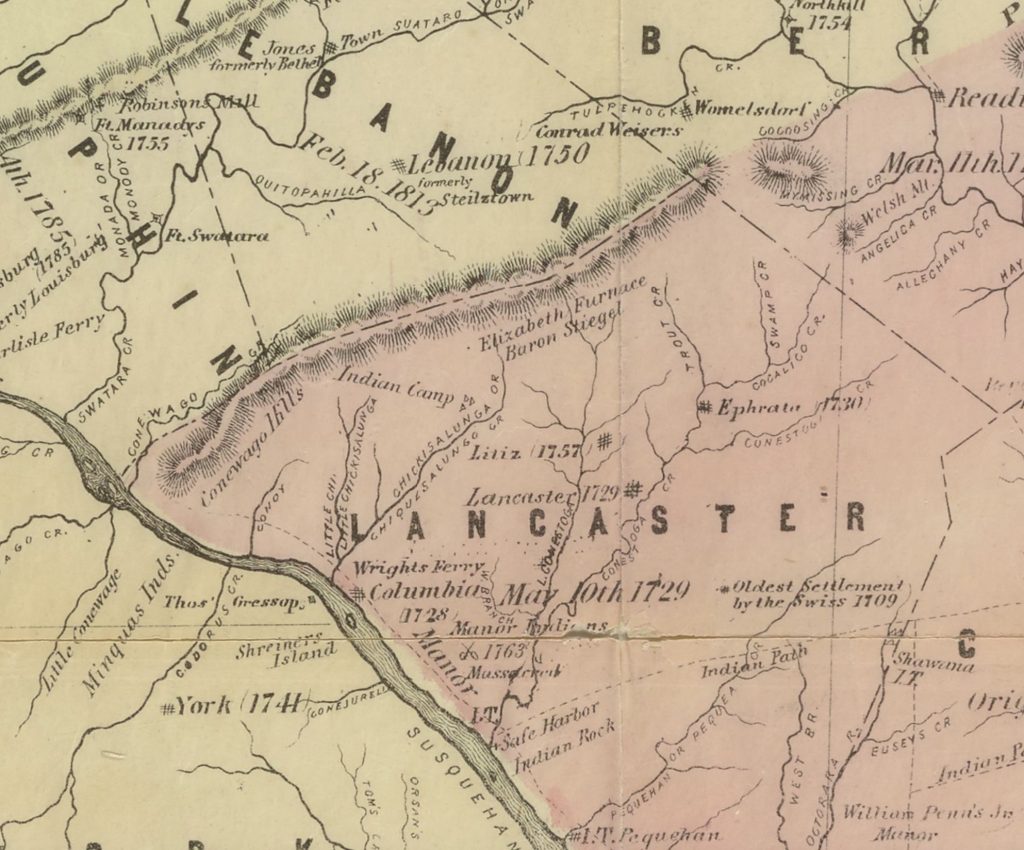The Native Americans Around Aberdeen Mills
When I think about the history of Aberdeen Mills and the surrounding areas – my thoughts seem to immediately go to the early Europeans who settled here. Perhaps this is because there is so much we know about the early white settlers in this area and relatively little is known about the native population around the Conewago, so I will start the story of what I do know with William Penn.
Willam Penn was awarded Penn’s Wood (Pennsylvania) as a way to settle a debt owed his deceased father by the king. He then visited or sent representatives to the native peoples, procured contracts with them and “bought” the land from them. This land was then sold to individuals who promised to develop and improve the land and also agreed to live peaceably with the native population. For many years, the native peoples and the new settlers developed trading agreements and friendly relationships with each other. Unfortunately, this peace was not to last.
The Native Americans who settled near the Aberdeen Mills area of the Conewago Creek appear to be the Conestogas (sadly, written history of native people in this area is scarce). The map below shows an “Indian” camp at the foot of the Conewago Hills.

This group was probably a remnant of the great tribe of Susquehannock. The Susquehannocks were largely wiped out by European diseases and alcohol, leaving them vulnerable to their eventual defeat by the Iroquois Confederacy. The remaining Susquehannocks moved into areas with other, friendlier tribes and became known as the Conestoga.
What happened next is best summed up by ExplorePAhistory.com when they wrote:
“During the first half of the eighteenth century “Conestoga” was an important post in the fur trading activities of Philadelphia merchants. William Penn established a manor near one of these Indian settlements, giving the village a further measure of protection. But Penn’s sons, who assumed the proprietorship of the colony after his death in 1718, exploited the region to enhance their own wealth.
Opening the Susquehanna frontier to German and Scots-Irish immigrants in order to collect rents from them, the Penn brothers jeopardized the welfare of the Conestoga people. Despite the acceptance of white ways, these Indians presence was an affront to, newly-arrived European immigrants, who believed that all Native Americans were alike, and detrimental to the interests of white settlers. When the French and Indian War ended two generations of peace between Pennsylvania and its Native American inhabitants, the security of the Conestogas became difficult to ensure. In 1763, “Pontiac’s Rebellion” in the Great Lakes Country spread into Pennsylvania, renewing hostilities between whites and Indians. Pennsylvanians, who had been ordered off their lands because of the Proclamation Line of 1763 prohibiting white settlement west of the Appalachian Mountains, sought revenge. On December 14th, German and Scots-Irish settlers from Paxton Township, just north of modern Harrisburg–some of whom had been displaced from settlements west of the Appalachian mountains–vented their anger on the village of Conestoga, burning it to the ground. Six Indians died in the attack and others were taken into protective custody at the Lancaster County Workhouse. Two weeks later, on December 27th, another mob from Paxton entered Lancaster and broke into the workhouse, killing more than a dozen Indians.”
Although unarmed and mostly elderly, women and children, they were slain and wiped out by the horrible actions of the “Paxton Boys”. To be clear, there were other groups of natives pillaging and murdering the white settlers – but the Conestogas were simply not in a position to, nor had a desire to harass their white neighbors. In fact, they took on many of the white settlers’ ways. It is a sad, terrible commentary on fear mongering, false accusations, mob justice and racism.
Today, on Indigenous Peoples Day, I hope we can reflect on the past – and plan a future that welcomes and appreciates diverse cultures. And most of all, may we take the time to learn our own history and promise that nothing like this would happen here ever again.




No responses yet